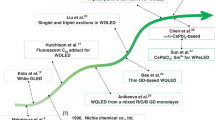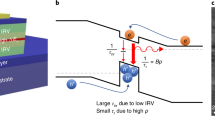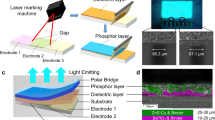Abstract
The currently ubiquitous light-emitting diodes (LEDs) have revolutionized the lighting industry. Contrary to common belief, however, LEDs are much more than just simple electricity-to-light converters. They are solid-state thermodynamic machines, theoretically capable of continuous and near-reversible energy conversion between electrical, thermal and optical energy. For over 50 years, the possibility of exploiting LEDs as efficient solid-state coolers has remained largely out of reach due to the high-material-quality requirements and commercial focus on light emission. Recent promising advances in electroluminescent cooling by LEDs, however, suggest that the remaining challenges in the area may be surmountable and practical cooling could be feasible. This Perspective discusses recent achievements in electroluminescent cooling, outlining the expected promise, the remaining challenges and their potential solutions.
This is a preview of subscription content, access via your institution
Access options
Access Nature and 54 other Nature Portfolio journals
Get Nature+, our best-value online-access subscription
$29.99 / 30 days
cancel any time
Subscribe to this journal
Receive 12 print issues and online access
$209.00 per year
only $17.42 per issue
Buy this article
- Purchase on Springer Link
- Instant access to full article PDF
Prices may be subject to local taxes which are calculated during checkout




Similar content being viewed by others
References
Solid-State Lighting Research and Development (US Department of Energy, 2012); http://apps1.eere.energy.gov/buildings/publications/pdfs/ssl/ssl_mypp2012_web.pdf
Round, H. J. A note on carborundum. Electr. World 49, 309 (1907).
Holonyak, N. & Bevacqua, S. F. Coherent (visible) light emission from Ga(As1−xPx) junctions. Appl. Phys. Lett. 1, 82–83 (1962).
Lehovec, K., Accardo, C. A. & Jamgochian, E. Light emission produced by current injected into a green silicon-carbide crystal. Phys. Rev. 89, 20–25 (1953).
Tauc, J. The share of thermal energy taken from the surroundings in the electro-luminescent energy radiated from a p–n junction. Czech. J. Phys. 7, 275–276 (1957).
Keyes, R. J. & Quist, T. M. Recombination radiation emitted by gallium arsenide. Proc. IRE 50, 1822–1823 (1962).
Dousmanis, G. C., Mueller, C. W., Nelson, H. & Petzinger, K. G. Evidence of refrigerating action by means of photon emission in semiconductor diodes. Phys. Rev. 133, A316–A318 (1964).
Hurni, C. A. et al. Bulk GaN flip-chip violet light-emitting diodes with optimized efficiency for high-power operation. Appl. Phys. Lett. 106, 031101 (2015).
Bender, D. A., Cederberg, J. G., Wang, C. & Sheik-Bahae, M. Development of high quantum efficiency GaAs/GaInP double heterostructures for laser cooling. Appl. Phys. Lett. 102, 252102 (2013).
Gauck, H., Gfroerer, T. H., Renn, M. J., Cornell, E. A. & Bertness, K. A. External radiative quantum efficiency of 96% from a GaAs/GaInP heterostructure. Appl. Phys. A 64, 143–147 (1997).
Schnitzer, I., Yablonovitch, E., Caneau, C. & Gmitter, T. J. Ultrahigh spontaneous emission quantum efficiency, 99.7% internally and 72% externally, from AlGaAs/GaAs/AlGaAs double heterostructures. Appl. Phys. Lett. 62, 131–133 (1993).
Santhanam, P., Gray, D. J. & Ram, R. J. Thermoelectrically pumped light-emitting diodes operating above unity efficiency. Phys. Rev. Lett. 108, 097403 (2012).
Santhanam, P., Huang, D., Ram, R. J., Remennyi, M. A. & Matveev, B. A. Room temperature thermo-electric pumping in mid-infrared light-emitting diodes. Appl. Phys. Lett. 103, 183513 (2013).
Oksanen, J. & Tulkki, J. Thermophotonic heat pump — a theoretical model and numerical simulations. J. Appl. Phys. 107, 093106 (2010).
Chen, K., Xiao, T. P., Santhanam, P., Yablonovitch, E. & Fan, S. High-performance near-field electroluminescent refrigeration device consisting of a GaAs light emitting diode and a Si photovoltaic cell. J. Appl. Phys. 122, 143104 (2017).
Xiao, T. P., Chen, K., Santhanam, P., Fan, S. & Yablonovitch, E. Electroluminescent refrigeration by ultra-efficient GaAs light-emitting diodes. J. Appl. Phys. 123, 173104 (2018).
Piprek, J. & Li, Z.-M. Electroluminescent cooling mechanism in InGaN/GaN light-emitting diodes. Opt. Quantum Electron. 48, 472 (2016).
Xue, J. et al. Thermally enhanced blue light-emitting diode. Appl. Phys. Lett. 107, 121109 (2015).
Sadi, T., Radevici, I., Kivisaari, P. & Oksanen, J. Electroluminescent cooling in III–V intracavity diodes: practical requirements. IEEE Trans. Electron Devices 66, 963–968 (2019).
Radevici, I. et al. Thermophotonic cooling in GaAs based light emitters. Appl. Phys. Lett. 114, 051101 (2019).
Santhanam, P., Huang, D., Gray, D. J. & Ram, R. J. Electro-luminescent cooling: light emitting diodes above unity efficiency. Proc. SPIE 8638, 863807 (2013).
Kuritzky, L. Y., Weisbuch, C. & Speck, J. S. Prospects for 100% wall-plug efficient III-nitride LEDs. Opt. Express 26, 16600–16608 (2018).
Pringsheim, P. Zwei bemerkungen uber den unterchied von luminneszenz- und temperaturstrahlung. Z. Phys. 57, 739–746 (1929).
Epstein, R. I., Buchwald, M. I., Edwards, B., Gosnell, T. R. & Mungan, C. E. Observations of laser induced fluorescent cooling of a solid. Nature 377, 500–503 (1995).
Thiede, J., Distel, J., Greenfield, S. R. & Epstein, R. I. Cooling to 208K by optical refrigeration. Appl. Phys. Lett. 86, 154107 (2005).
Sheik-Bahae, M. & Epstein, R. I. Can laser light cool semiconductors? Phys. Rev. Lett. 92, 247403 (2004).
Sheik-Bahae, M. & Epstein, R. I. Optical refrigeration. Nat. Photon. 1, 693–699 (2007).
Hehlen, M. P. et al. First demonstration of an all-solid-state optical cryocooler. Light Sci. Appl. 7, 15 (2018).
Lin, C., Wang, B., Teo, K. H. & Zhang, Z. A coherent description of thermal radiative devices and its application on the near-field negative electroluminescent cooling. Energy 147, 177–186 (2018).
Harder, N.-P. & Green, M. A. Thermophotonics. Semicond. Sci. Technol. 18, S270–S278 (2003).
Lin, K. L., Catchpole, K. R., Campbell, P. & Green, M. A. High external quantum efficiency from double heterostructure InGaP/GaAs layers as selective emitters for thermophotonic systems. Semicond. Sci. Technol. 19, 1268–1272 (2004).
Lin, K. L. et al. Thin semiconducting layers as selective emitters in thermophotonic systems. In Conference Record of the Twenty-Ninth IEEE Photovoltaic Specialists Conference 939–942 (IEEE, 2002).
Farrell, D. J., Sodabanlu, H., Wang, Y., Sugiyama, M. & Okada, Y. A hot-electron thermophotonic solar cell demonstrated by thermal up-conversion of sub-bandgap photons. Nat. Commun. 6, 8685 (2015).
Zhao, B., Santhanam, P., Chen, K., Buddhiraju, S. & Fan, S. Near-field thermophotonic systems for low-grade waste-heat recovery. Nano Lett. 18, 5224–5230 (2018).
Zhao, B., Buddhiraju, S., Santhanam, P., Chen, K. & Fan, S. Self-sustaining thermophotonic circuits. Proc. Natl Acad. Sci. USA 116, 11596–11601 (2019).
Würfel, P. The chemical potential of radiation. J. Phys. C 15, 3967–3985 (1982).
Riffat, S. B. & Ma, X. Improving the coefficient of performance of thermoelectric cooling systems: a review. Int. J. Energy Res. 28, 753–768 (2004).
Aspnes, D. E., Kelso, M., Logan, R. A. & Bhat, R. Optical properties of AlxGa1−xAs. J. Appl. Phys. 60, 754–767 (1986).
Ward, J. S. et al. Techno-economic analysis of three different substrate removal and reuse strategies for III–V solar cells. Prog. Photovolt. 24, 1284–1292 (2016).
Catchpole, K. R. et al. High external quantum efficiency of planar semiconductor structures. Semicond. Sci. Technol. 19, 1232–1235 (2004).
Min, G. & Rowe, D. M. Conditions for observing the thermo-electro-photo cooling effect. IET Sci. Meas. Technol. 1, 329–332 (2007).
Heikkilä, O., Oksanen, J. & Tulkki, J. Ultimate limit and temperature dependency of light-emitting diode efficiency. J. Appl. Phys. 105, 093119 (2009).
Malshukov, A. G. & Chao, K. A. Opto-thermionic refrigeration in semiconductor heterostructures. Phys. Rev. Lett. 86, 5570–5573 (2001).
Han, P. et al. Analysis of optothermionic refrigeration based on semiconductor heterojunction. J. Appl. Phys. 99, 074504 (2006).
Ram, R. J. Thermophotonics for ultra-high efficiency visible LEDs. Proc. SPIE 10124, 1012414 (2017).
Olsson, A. et al. Optical energy transfer and loss mechanisms in coupled intracavity light emitters. IEEE Trans. Electron Devices 63, 3567–3573 (2016).
Huang, D., Santhanam, P. & Ram, R. J. Low-power communication with a photonic heat pump. Opt. Express 22, A1650–A1658 (2014).
Radevici, I., Tiira, J. & Oksanen, J. Lock-in thermography approach for imaging the efficiency of light emitters and optical coolers. Proc. SPIE 10121, 101210Q (2017).
Radevici, I., Tiira, J., Sadi, T. & Oksanen, J. Influence of photo-generated carriers on current spreading in double diode structures for electroluminescent cooling. Semicond. Sci. Technol. 33, 05LT01 (2018).
Sadi, T. et al. Electroluminescent cooling in intracavity light emitters: modeling and experiments. Opt. Quantum Electron. 50, 18 (2018).
Sadi, T., Radevici, I., Kivisaari, P. & Oksanen, J. Electroluminescent cooling in III–V intracavity diodes: efficiency bottlenecks. IEEE Trans. Electron Devices 66, 2651–2656 (2019).
Gilliland, G. D., Wolford, D. J., Kuech, T. F., Bradley, J. A. & Hjalmarson, H. P. Minority-carrier recombination kinetics and transport in surface-free GaAs/AlxGa1−xAs double heterostructures. J. Appl. Phys. 73, 8386 (1993).
Nelson, R. J. & Sobers, R. G. Minority-carrier lifetimes and internal quantum efficiency of surface free GaAs. J. Appl. Phys. 49, 6103–6108 (1978).
Broell, M. et al. New developments on high-efficiency infrared and InGaAlP light-emitting diodes at OSRAM Opto Semiconductors. Proc. SPIE 9003, 90030L (2014).
Li, N. et al. Ultra-low-power sub-photon-voltage high-efficiency light-emitting diodes. Nat. Photon. 13, 588–592 (2019).
Baca, A. G. & Ashby, C. I. H. Fabrication of GaAs Devices (The Institution of Engineering and Technology, 2005).
Wada, Y. & Wada, K. GaAs surface passivation by deposition of an ultrathin InP-related layer. Appl. Phys. Lett. 63, 379–381 (1993).
Levinshtein, M., Rumyantsev, S. & Shur, M. Ternary and Quaternary III–V Compounds (Handbook Series on Semiconductor Parameters, World Scientific Publishing, 1999).
Punkkinen, M. P. J. et al. Oxidized In-containing III–V(100) surfaces: formation of crystalline oxide films and semiconductor-oxide interfaces. Phys. Rev. B 83, 195329 (2011).
Strauss, U., Rühle, W. W. & Köhler, K. Auger recombination in intrinsic GaAs. Appl. Phys. Lett. 62, 55–57 (1993).
Espinet-González, P. et al. Analysis of perimeter recombination in the subcells of GaInP/GaAs/Ge triple-junction solar cells. Prog. Photovolt. 23, 874–882 (2015).
Guo, X. & Schubert, E. F. Current crowding and optical saturation effects in GaInN/GaN light-emitting diodes grown on insulating substrates. Appl. Phys. Lett. 78, 3337–3339 (2001).
Kuritzky, L. Y. et al. High wall-plug efficiency blue III-nitride LEDs designed for low current density operation. Opt. Express 25, 30696–30707 (2017).
Li, Z., Xue, J. & Ram, R. A design of a PhC-enhanced LED for electroluminescence cooling. Proc. SPIE 10121, 1012108 (2017).
Myllynen, A., Sadi, T. & Oksanen, J. Diffusion-driven GaInP/GaAs light-emitting diodes enhanced by modulation doping. Opt. Quantum Electron. 51, 90 (2019).
Miller, O. D., Yablonovitch, E. & Kurtz, S. R. Strong internal and external luminescence as solar cells approach the Shockley–Queisser limit. IEEE J. Photovolt. 2, 303–311 (2012).
Green, M. A. et al. Solar cell efficiency tables (version 54). Prog. Photovolt. 27, 565–575 (2019).
Chen, H.-L. et al. A 19.9%-efficient ultrathin solar cell based on a 205-nm-thick GaAs absorber and a silver nanostructured back mirror. Nat. Energy 4, 761–767 (2019).
Perl, E. E. et al. Measurements and modeling of III–V solar cells at high temperatures up to 400°C. IEEE J. Photovolt. 6, 1345–1352 (2016).
Steiner, M. A. et al. AlGaInP/GaAs tandem solar cells for power conversion at 400°C and high concentration. AIP Conf. Proc. 1881, 040007 (2017).
Tsao, J. Y. et al. Toward smart and ultra-efficient solid-state lighting. Adv. Optical Mater. 2, 809–836 (2014).
Acknowledgements
We acknowledge funding from the Academy of Finland, the Photonics Research and Innovation (PREIN) flagship programme and the European Research Council under the Horizon 2020 research and innovation programme (grant agreement number 638173). We acknowledge the provision of facilities and technical support by Aalto University at the Micronova Nanofabrication Centre.
Author information
Authors and Affiliations
Corresponding author
Ethics declarations
Competing interests
The authors declare no competing interests.
Additional information
Publisher’s note Springer Nature remains neutral with regard to jurisdictional claims in published maps and institutional affiliations.
Rights and permissions
About this article
Cite this article
Sadi, T., Radevici, I. & Oksanen, J. Thermophotonic cooling with light-emitting diodes. Nat. Photonics 14, 205–214 (2020). https://doi.org/10.1038/s41566-020-0600-6
Received:
Accepted:
Published:
Issue Date:
DOI: https://doi.org/10.1038/s41566-020-0600-6
This article is cited by
-
Minimizing heat generation in quantum dot light-emitting diodes by increasing quasi-Fermi-level splitting
Nature Nanotechnology (2023)
-
Ultralow-voltage operation of light-emitting diodes
Nature Communications (2022)
-
Highly-efficient thermoelectric-driven light-emitting diodes based on colloidal quantum dots
Nano Research (2022)
-
High-performance photonic transformers for DC voltage conversion
Nature Communications (2021)
-
Thermoelectric characteristics of X\(_2\)YH\(_2\) monolayers (X=Si, Ge; Y=P, As, Sb, Bi): a first-principles study
Scientific Reports (2021)



